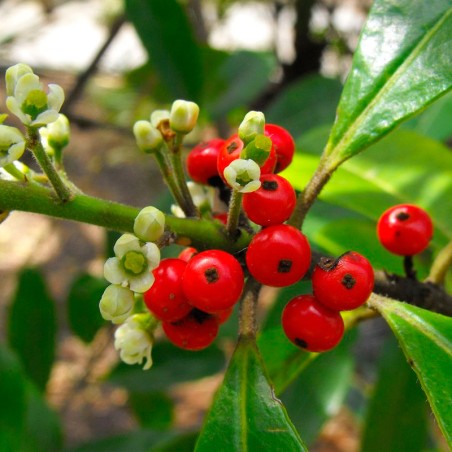- Out-of-Stock





Perennifolium tree originating from South America, also known as the grass of the Jesuits or Yerba del Paraguay. This tree can reach 15 meters high.
Yerba mate (Ilex paraguariensis) is a fascinating plant both for its origins and its various uses. Originating from the Paraná River basin region in South America, especially in countries like Argentina, Brazil, Paraguay, and Uruguay, yerba mate has been used for centuries by the indigenous Guarani people. These communities prepared an infusion from the dried leaves of the plant, known as "mate," which not only provided them with energy and endurance but also played an important social and ceremonial role. Today, mate has become a traditional and culturally significant beverage in many South American countries, enjoyed for its stimulating effects due to its caffeine content, as well as for its antioxidant properties and its capacity to foster social interactions.
From a botanical perspective, yerba mate belongs to the Aquifoliaceae family, the same family as holly. It is an evergreen tree that can reach up to 15 meters in height in its natural habitat, though it is kept shorter in cultivation to facilitate harvesting. Its leaves are leathery, oblong with serrated edges, dark green on the upper side, and lighter on the underside. Yerba mate flowers are small and white, arranged in axillary clusters. The fruit is a globose drupe of reddish-purple color, containing a single seed. This plant has a remarkable ability to adapt to different soil and climate conditions, which contributes to its widespread distribution and cultivation.
The cultivation of yerba mate requires specific conditions to thrive. It prefers subtropical climates with moderate temperatures and high humidity, typical of the regions where it is traditionally grown. The ideal soil for its cultivation is deep, well-drained, and rich in organic matter. The cultivation process includes planting seeds or cuttings, which develop in nurseries before being transplanted to the field. Yerba mate plants need about 4 to 5 years to reach maturity and be ready for harvest. The leaves are typically harvested once a year, and after harvesting, they undergo a drying and curing process that includes sapeco (brief exposure to fire), drying, and milling for final consumption. This careful process ensures that yerba mate retains its organoleptic characteristics and beneficial properties.
Data sheet
No customer questions for the moment.